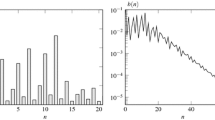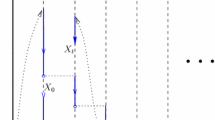Abstract
The purpose of this paper is to review, unify, and extend previous work on sample-path analysis of queues. Our main interest is in the asymptotic behavior of a discrete-state, continuous-time process with an imbedded point process. We present a sample-path analogue of the renewal-reward theorem, which we callY=λX. We then applyY=λX to derive several relations involving the transition rates and the asymptotic (long-run) state frequencies at an arbitrary point in time and at the points of the imbedded point process. Included are sample-path versions of the rate-conservation principle, the global-balance conditions, and the insensitivity of the asymptotic frequency distribution to the distribution of processing time in a LCFS-PR service facility. We also provide a natural sample-path characterization of the PASTA property.
Similar content being viewed by others
References
S. Asmussen,Applied Probability and Queues (Wiley, New York, 1987).
F. Baccelli and P. Bremaud,Palm Probabilities and Stationary Queues, Lecture Notes in Statistics 41 (Springer-Verlag, New York, 1987).
P. Brémaud, Characteristics of queueing systems observed at events and the connection between stochastic intensity and Palm probability, Questa 5 (1989) 99–112.
P. Brill and M. Posner, Level crossing in point processes applied to queues: single-server case, Oper. Res. 25 (1977) 662–674.
P. Brill and M. Posner, The system point method in exponential queues: a level crossing approach, Math. of Oper. Res. 6 (1981) 31–49.
R. Bryant, On homogeneity on on-line=off-line behavior in M/G/1 queueing systems, IEEE Trans. Software Engineering SE-7 (1981) 291–299.
J. Buzen, Fundamental operational laws of computer system performance, Acta Informatica 7 (1976) 167–182.
J. Buzen, Operational analysis: an alternative to stochastic modelling, in:Performance of Computer Installations, ed. D. Ferrari (North-Holland, Amsterdam, 1978) 175–194.
J. Buzen and P. Denning, Measuring and calculating queue-length distributions, IEEE Trans. Computers C-18 (1980) 33–44.
E. Cinlar,Introduction to Stochastic Processes (Prentice-Hall, Englewood Cliffs, NJ, 1975).
J. Cohen,On Regenerative Processes in Queueing Theory, Lecture Notes in Economics and Mathematical Systems 121 (Springer-Verlag, Berlin, 1976).
R. Cooper,Introduction to Queueing Theory, 2nd ed. (North-Holland, New York, 1981).
P. Denning and J. Buzen, The operational analysis of queueing network models, ACM Computing Surveys 10 (1978) 226–261.
M. El Taha, Sample-path analysis of queueing systems: new results, Ph.D. dissertation, Program in Operations Research, N.C. State University, Raleigh, 1986.
P. Franken, D. König, U. Arndt and V. Schmidt,Queues and Point Processes (Wiley, New York, 1982).
E. Gelenbe, Stationary deterministic flow in discrete systems I, Theoretical Computer Science 23 (1983) 107–128.
E. Gelenbe and D. Finkel, Stationary deterministic flows II: the single-server case, Theoretical Computer Science 52 (1987) 269–280.
L. Green and B. Melamed, An anti-PASTA result for Markovian systems, Oper. Res. (1990), to appear.
P. Glynn and W. Whitt, A central-limit version ofL=λW, Questa 1 (1986) 191–215.
P. Glynn and W. Whitt, Extensions of the queueing relationsL=λW andH=λG, Oper. Res. (1989), to appear.
S. Halfin and W. Whitt, An ordinal version ofL=λW, Technical Report, Bell Communications Research, 1988.
D. Heyman, The use of level-crossing analysis to relate customer and time averages, Technical Report, Bell Communications Research, 1986.
D. Heyman and M. Sobel,Stochastic Models in Operations Research, Vol. I (McGraw-Hill, New York, 1982).
D. Heyman and S. Stidham, The relation between customer and time averages in queues, Oper. Res. 28 (19980) 983–994.
J. Keilson, The use of Green's functions in the study of random walks, with applications to queueing theory, J. Math. and Phys. 41 (1962) 42–52.
F. Kelly,Reversibility and Stochastic Networks (Wiley, New York, 1979).
D. König, K. Matthes and K. Nawrotzki,Generalization of the Erlang and Engset Formulae (A Method in Queueing Theory) (Akademie-Verlag, Berlin, 1967).
D. König and V. Schmidt, Imbedded and non-imbedded stationary characteristics of queueing systems with varying service rate and point processes. J. Appl. Prob. 17 (1980) 753–767.
D. König, A comparison of distributional and intensity approaches in queueing theory, Questa, to appear.
R. Loynes, Some results in the probabilistic theory of asymptotic uniform distribution modulo 1, Z. Wahrscheinlichkeitstheorie verw. Geb. 26 (1973) 33–41.
B. Melamed, On Markov jump processes imbedded at jump epochs and their queueing-theoretic applications, Math. Opns. Res. 7 (1982) 11–128.
B. Melamed and W. Whitt, On arrivals that see time averages, preprint, Oper. Res. (1990), to appear.
B. Melamed and W. Whitt, On arrivals that see time averages: a martingale approach, J. Appl. Prob. (1989), to appear.
M. Miyazawa, The intensity conservation law for queues with randomly changed service rate, J. Appl. Prob. 22 (1985) 408–418.
M. Miyazawa, Approximation of the queue-length distribution of an M/GI/s queue by the basic equations, J. Appl. Prob. 23 (1986) 443–458.
M. Miyazawa, A generalized Pollaczek-Khintchine formula for the GI/GI/1/K queue and its application to approximation, Commun. Statist.-Stochastic Models 3 (19987) 53–65.
T. Rolski,Stationary Random Processes Associated with Point Processes, Lecture Notes in Statistics 5 (Springer-Verlag, Berlin-New York, 1981).
T. Rolski and S. Stidham, Continuous versions of the formulasL=λW and H=λG, Oper. Res. Letters 2 (1983) 211–215.
S. Ross,Stochastic Processes (Wiley, New York, 1983).
R. Serfozo, Semi-stationary processes, Z. Wahrscheinlichkeitstheorie verw. Geb. 23 (1972) 125–132.
R. Serfozo, Functional limit theorems for stochastic processes based on embedded processes, Adv. Appl. Prob. 7 (1975) 123–139.
R. Serfozo, Point processes, draft for chapter in:Operations Research Handbook on Stochastic Processes, July 1989.
R. Serfozo, Poisson functionals of Markov processes and queueing networks, preprint, Department of Industrial and Systems Engineering, Georgia Institute of Technology, 1988.
M. Shaked and J.G. Shanthikumar, Stochastic convexity and its applications, Adv. Appl. Prob. 20 (1988) 427–446.
G. Shanthikumar and U. Sumita, On G/G/1 queues with LIFO-P service discipline, J. Oper. Res. Soc. Japan 29 (1986) 220–231.
G. Shanthikumar and D. Yao, Stochastic monotonicity of the queue lengths in closed queueing networks, Opns. Res. 35 (1987) 583–588.
G. Shanthikumar and D. Yao, Second-order properties of the throughput in a closed queueing network, Math. Opns. Res. 13 (1988) 524–534.
M. Sobel, The optimality of full-service policies, Opns. Res. 30 (1982) 636–649.
S. Stidham, On the optimality of single-server queueing systems, Opns. Res. 18 (1970) 708–732.
S. Stidham, Regenerative processes in the theory of queues, with applications to the alternating-priority queue, Adv. Appl. Prob. 4 (1972) 542–577.
[51]S. Stidham,L=λW: a discounted analogue and a new proof, Oper. Res. 20 (1972) 708–732.
S. Stidham, A last word onL=λW, Oper. Res. 22 (1974) 417–421.
S. Stidham, On the relation between time averages and customer averages in stationary random marked point processes, Tech. Rpt. No. 79-1, Department of Industrial Engineering, N.C. State University, Raleigh, 1979.
S. Stidham, Sample-path analysis of queues, in:Applied Probability and Computer Science: The Interface, Vol. II, eds. R. Disney and T. Ott (Birkhauser, Boston, 1982) 41–70.
S. Stidham, Computing optimal control policies for queueing systems, in:Proc. 24th IEEE Conf. on Decision and Control (1985) 1810–1814.
S. Stidham, Stable recursive procedures for numerical computations in Markov models, Annals of Oper. Res. 8 (1987) 27–40.
S. Stidham and R. Weber, Monotonic and insensitive optimal policies in the control of queues with undiscounted costs, Oper. Res. 37 (1989) (to appear).
W. Whitt, Heavy-traffic limit theorems for queues: a survey, in:Mathematical Methods in Queueing Theory, ed. A.B. Clarke, Lecture Notes in Economics and Mathematical Systems No. 98, 307–350 (Springer-Verlag, Berlin, 1974).
W. Whitt, Some useful functions for functional limit theorems, Math. of Opns. Res. 5 (1980) 67–85.
W. Whitt, Comparing counting processes and queues, Adv. Appl. Prob. 13 (1981) 207–220.
J. Wijngaard and S. Stidham, Forward recursion for Markov decision processes with skip-free-to-the-right transitions, part I: theory and algorithm, Math, of Opns. Res. 11 (1986) 295–308.
R. Wolff, Poisson arrivals see time averages, Oper. Res. 30 (1982) 223–231.
R. Wolff,Stochastic Modeling and the Theory of Queues (Prentice-Hall, Englewood Cliffs, NJ, 1989).
D. Yao and G. Shanthikumar, The optimal input rates to a system of manufacturing cells, INFOR 25 (1987) 57–65.
Author information
Authors and Affiliations
Additional information
The research of this author was partially supported by the U.S. Army Research Office, Contract DAAG29-82-K-0151 at N.C. State University, and by the National Science Foundation, Grant No. ECS-8719825, at the University of North Carolina, Chapel Hill.
The research of this author was partially supported by the U.S. Army Research Office, Contract DAAG29-82-K-0151 at N.C. State University.
Rights and permissions
About this article
Cite this article
Stidham, S., Taha, M.E. Sample-path analysis of processes with imbedded point processes. Queueing Syst 5, 131–165 (1989). https://doi.org/10.1007/BF01149190
Received:
Revised:
Issue Date:
DOI: https://doi.org/10.1007/BF01149190




